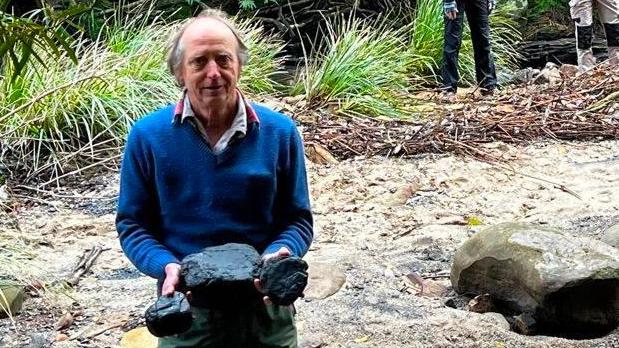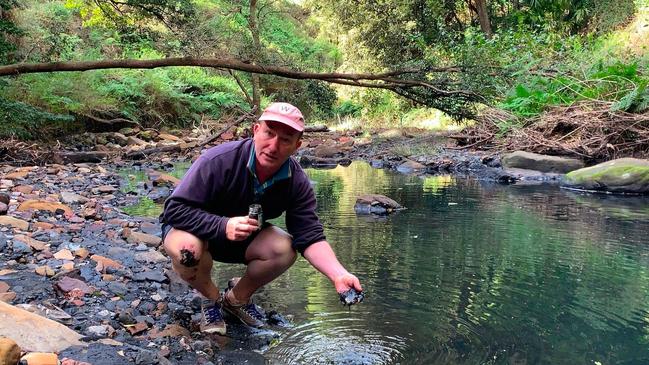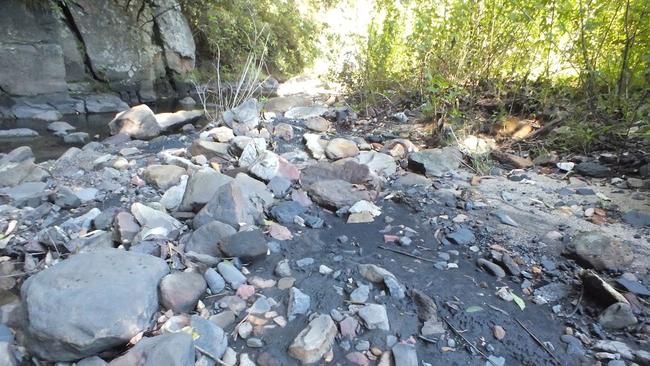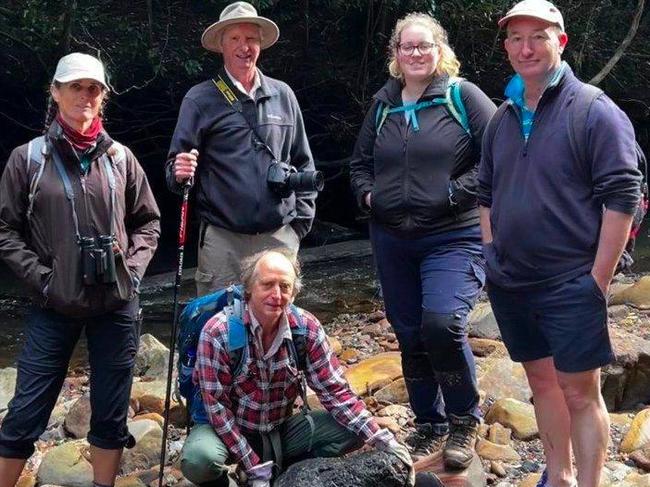Concerns raised about water quality after coal found in Royal National Park waterways
An environmental group has raised concerns about a plan to reintroduce platypus into the Royal National Park after members were “shocked” to find water polluted with chunks of coal.
St George Shire Standard
Don't miss out on the headlines from St George Shire Standard. Followed categories will be added to My News.
A coalition of scientists and environmentalists have been left shocked and dismayed by the level of pollution found in a Royal National Park waterway.
It has left them with real concerns about a plan to reintroduce platypus, which were last seen in 2006, back into the ecosystem.
Members of the Sutherland Shire Environment Centre and water scientist Dr Ian Wright went to Hacking River, located near Peabody’s Metropolitan Colliery, on the weekend to look at and assess the state of the water.
What they found were chunks of coal, fine particles and a black river.

Environment centre spokeswoman Dr Catherine Reynolds said members had been flagging concerns about mine pollution escaping from the site into the Royal National Park for years.
“The EPA has stated the impact of the pollution is minor, but we’ve visited the site several times over the last few years,” she said.
“This is not a small amount of pollution: it is significant and it is ongoing.”
Dr Wright said he held “grave concerns” about the water quality of the Hacking River, especially after a plan was announced to reintroduce platypus back into the Royal National Park.
This new project, announced in September last year, will translocate an initial group of 10 platypus, a mixture of males and females, in the first half of 2022.
The conservation initiative has been planned with the University of New South Wales (UNSW), the World Wild Fund for Nature-Australia (WWF), Taronga Conservation Society Australia and National Parks.
NPWS will also be investing in public viewing infrastructure once the initial population is established, it was announced.

“I have been told there have been no verified sightings of platypus in about 15 years,” he said.
“The proposal is emotive and excites me but in the back of my mind is the question of why did the platypus die out and how good is the river at supporting them?
“After the quick look on the weekend, the concerns I have about the water quality justifies further examination.
“It was obvious the river was quite black and loaded with fine coal that has likely been washed off from the Metropolitan mine.
“I’m not out for scalps, but I don’t want to see platypus trapped and moved from their healthy environments and condemned to death if the river can’t support them.”

Dr Wright, who works for the University of Western Sydney, noted he was not yet conducting an official study into the water quality but hoped to discuss this in the future with the National Parks and Wildlife Service.
He said there could not be other reasons for the water to be polluted and therefore it needed to be investigated further, adding the study should be independently undertaken.
Dr Wright said he had carried out extensive research on other coal mines and water pollution during his career and noted the EPA licence for the colliery was “very weak”.
In June 2022, the EPA issued a $15,000 fine to Metropolitan Colliery for failure to maintain and operate equipment in a reasonable manner when a blocked drain resulted in discharge of fine coal material to Camp Creek during heavy rains in January, which the environmental centre members believed was “manifestly inadequate”.

Dr Reynolds said it was evident fine coal sediment pollution and large chunks of coal were still escaping the mine, eight months after the pollution event.
“What is troubling is that the EPA fine was for a pollution event in January. The EPA claimed remediation was not necessary,” she said.
Dr Reynolds also noted the colliery’s flexible or “lax” EPA licence allowed water pollution to be discharged from its holding dams and did not require the colliery to test for platypus.
She said she was concerned about pollution in the Royal National Park, "which is the best known and loved national park".
“What we saw was shocking,” Dr Reynolds said.

“Our members have been going to look at the waterway for the past two years, over several trips where we took photos and we have seen coal pollution on the banks of the Hacking River since 2019.
“We would like the EPA to take a closer look at what is happening in the area.
“We want more rigorous testing from the government to make sure the colliery’s pollution events stop.”
A NSW EPA spokeswoman said the EPA regulated the Metropolitan Mine in Helensburgh under an Environment Protection Licence which included limiting and monitoring conditions to control the quality of water that can be discharged to Camp Creek, a tributary of the Hacking River to protect the environment.
“The company has since employed an expert consultant to review and make recommendations to improve the stormwater management system and overall environmental performance. The improvement works are expected to be completed by December 2022,” the spokeswoman said.
“The EPA continues to undertake routine inspections of the mine to monitor compliance with environment protection licence conditions.”

The spokeswoman noted the water quality in the Hacking River was affected by various sources of pollution including run-off from urban areas, livestock holdings and activities like legal and illegal trail bikes and off road vehicles.
“The EPA has inspected the Hacking River and observed that it contains pieces of coal of various sizes in the riverbed which is predominantly from historical mining practices which were under the pre-1970 pollution control act legislation,” she said.
“This coal poses a minimal risk as coal mined in the Illawarra area has relatively low levels of leachable contaminants.
“Removing it from the Hacking River would require significant disturbance of the riverbed and removal of vegetation in areas of the National Park to provide access for heavy equipment and would likely do more environmental harm to the river than good.”

Greens MLC Cate Faerhmann raised the issue of the mine pollution in the Royal National Park in parliament in late 2021, noting community concerns about ongoing impacts.
Dr Reynolds said questions Ms Faerhmann asked about remediation remain unanswered.
Another member of the environment centre, Ricki Coughlan, said if there were problems from an external source then all stakeholders needed to understand what caused it and how to repair the situation.
“National parks are our last hope for our environment to evolve because everywhere else is subject to numerous insults and degradation,” she said.
“We need to at least maintain the nature and make sure the parks are properly managed.
“Hopefully we can raise these matters to the EPA and get it to look more closely at the area.”
The members of the group also noted invertebrate life, including water spiders, ‘boatman’ beetles, diving beetles, and swarms of small insects above the water, had been disappearing from the Hacking River for years.

A Peabody spokeswoman said the mining company took its environmental responsibilities seriously.
“The company has taken immediate actions to rectify the issues brought to light by the extreme rain that affected the Illawarra region in the first half of 2022,” she said.
“From January to the end of July this year, the mine has received almost 2500mm of rain, nearly double the expected annual rainfall in just seven months.
“We continue to work cooperatively with the Environment Protection Agency to better prepare for future heavy rain events, including the commissioning of a full review of onsite surface water management, the desilting of stormwater dams and civil works to create an additional pathway for excess stormwater to be captured on site.”





